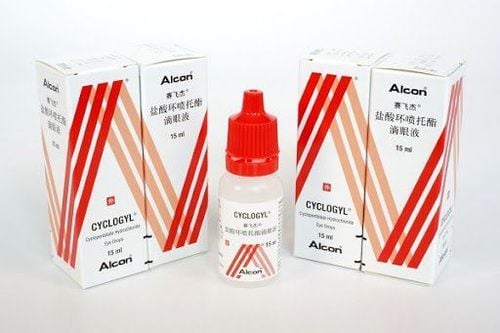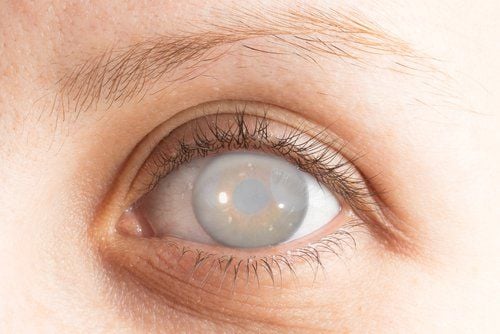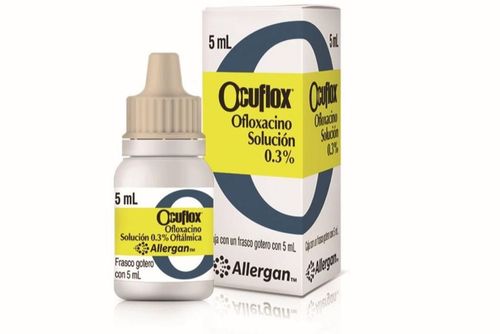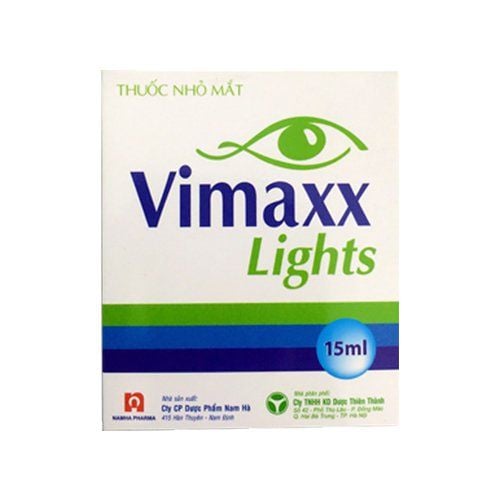This is an automatically translated article.
Cyclogyl, also known as Cyclopentolate, is an anticholinergic drug that is usually taken before an eye exam. The drug causes a reaction to dilate the pupils and muscles around the eyes, making it convenient to examine eye diseases.
1. What is the effect of Cyclogyl?
Cyclogyl is often used before an eye exam (eg, a refractive test). It works by temporarily widening (dilating) the pupil of the eye and relaxing the muscles around the eye.
2. How to use Cyclogyl
Cyclogyl is usually applied to the eye 40 to 50 minutes before the procedure or as directed by your doctor. Dosage may be repeated after 5 to 10 minutes. Cyclogyl is only for eyes, absolutely do not drink or inject this medicine.
Instructions for using Cyclogyl medicine are as follows:
Wash your hands before putting the medicine in your eyes. To avoid contamination, do not touch the tip of the dropper with your hands or let it touch your eyes or any other surface. If you are wearing contact lenses, remove them before instilling this medication. Tilt your head back, bring your eyes up, and pull your lower eyelid down to create an opening. Hold the dropper directly to the surface of the eye. Lower your gaze and gently close your eyes for 1 to 2 minutes. Place a finger in the corner of the eye and gently press for 2-3 minutes to prevent the medication from draining out of the eye and reduce side effects. Try not to blink and rub your eyes. Accordingly, it should be noted, if you are using Cyclogyl for children, you should monitor to avoid the drug coming into contact with the child's mouth. You and your child's hands should be washed after administering the medication to remove the medication.
Cyclogyl may temporarily change the digestive condition in infants. Therefore, parents need to pay attention not to feed their babies within 4 hours of having their eyes examined. In fact, the drug Cyclogyl works quite quickly, in just a few minutes. The drug's effects last 24 hours or sometimes longer. Tell your doctor if you continue to have blurred vision, light sensitivity, or dilated pupils several days after the exam.

Thuốc Cyclogyl có thể sử dụng cho trẻ em nhưng cần chú ý an toàn
3. Cyclogyl side effects
Some side effects of Cyclogyl may be:
Burns, stinging eyes. Red eyes. Eye irritation or temporary blurred vision Tell your doctor if you notice any serious side effects such as:
Pain, swelling of the eyes. Vision changes (seeing rainbows around lights at night). Psychological changes (eg, hallucinations, restlessness, strange behavior, confusion). Breathe slowly, shallowly. Fast or irregular heartbeat. Dizzy . Faint. Convulsions . Serious allergic reactions such as itching, swelling (especially in the face, tongue, and throat), rash, severe dizziness, trouble breathing, etc. are all very rare side effects.
4. Measures to prevent side effects of Cyclogyl
Before taking Cyclopentolate, tell your doctor if you are allergic to the drug or have any other allergic conditions. In addition, patients should consult a doctor if there is a personal or family history of glaucoma, Down syndrome, brain damage or spastic paralysis (in children), cardiovascular disease.
After instilling this medicine, vision may be temporarily blurred. Therefore, you should not drive, use machinery or equipment, or perform any activity that requires clear vision until you can safely operate such activities.
Cyclogyl may make your eyes more sensitive to light. Please cover and protect your eyes from strong light, wear sunglasses when going out in the sun. Use caution when giving this medicine to infants or young children as they may be more sensitive to its side effects, especially mental or mood changes. If Cyclogyl is given to an infant, monitor the child closely for 30 minutes after instillation. In addition, caution should be exercised when giving this drug to the elderly because this group is more susceptible to its side effects, especially glaucoma.
During pregnancy, Cyclogyl should only be used when absolutely necessary. Discuss the risks and benefits of the medication with your doctor before taking it. It is not known whether Cyclogyl passes into breast milk. Therefore, consult your doctor before taking the medicine.

Cyclogyl có tác dụng gì khiến nhiều người băn khoăn
5. Cyclogyl drug interactions
Before using this medicine, tell your doctor about all prescription and nonprescription medicines you may use, especially of:
Medicines for glaucoma (such as Dorzolamide, Pilocarpine) ; certain antiarrhythmic drugs (such as quinidine); Antihistamines (such as Diphenhydramine, Meclizine); Antispasmodics (such as Dicyclomine); certain Parkinson's medications (including anticholinergics such as Trihexyphenidyl); MAO inhibitors (such as Isocarboxazid, Linezolid, Methylene Blue, Moclobemide, Pheilazine, Rasnamide, Rasnamide, Selegiline, Tranylcypromine); Tricyclic antidepressants (such as Amitriptyline).
6. Treatment in case of overdose and how to store
Cyclogyl can be harmful if swallowed. If you accidentally overdose on this medication, you may experience symptoms such as: flushing, dry skin, blurred vision, fast (irregular) heartbeat, fever, vision changes (e.g. hallucinations), loss of coordination. The drug should be stored at room temperature (8-27 degrees Celsius), away from moisture, light and out of reach of children and pets.
Cyclogyl is an anticholinergic drug that is often used before an eye exam. To avoid unwanted side effects, patients should read the instructions carefully before using or follow the doctor's instructions.
Please dial HOTLINE for more information or register for an appointment HERE. Download MyVinmec app to make appointments faster and to manage your bookings easily.
Reference source: webmd.com













